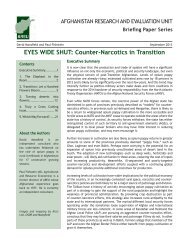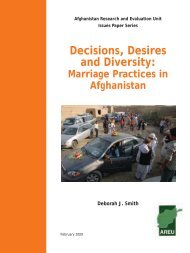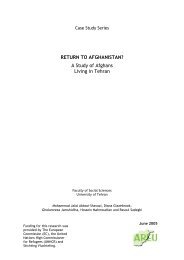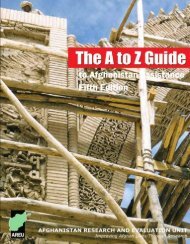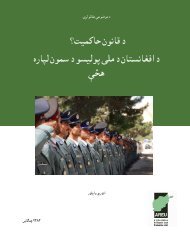Local Governance in Afghanistan: A View from the Ground
Local Governance in Afghanistan: A View from the Ground
Local Governance in Afghanistan: A View from the Ground
- No tags were found...
Create successful ePaper yourself
Turn your PDF publications into a flip-book with our unique Google optimized e-Paper software.
<strong>Afghanistan</strong> Research and Evaluation Unit<br />
2011<br />
employed someone to br<strong>in</strong>g water <strong>from</strong> a source 200 metres away <strong>from</strong> <strong>the</strong>ir compound. In such<br />
districts noth<strong>in</strong>g can be undertaken without Taliban (or HIA) consent. Consequently, woluswals <strong>in</strong><br />
prov<strong>in</strong>ces such as Wardak and Helmand work with <strong>the</strong>ir lives under constant threat, and many hedge<br />
<strong>the</strong>ir bets by ma<strong>in</strong>ta<strong>in</strong><strong>in</strong>g l<strong>in</strong>ks with <strong>the</strong> armed opposition.<br />
3.3 Plann<strong>in</strong>g and resource allocation<br />
Prov<strong>in</strong>cial Development Committees <strong>in</strong> <strong>the</strong> study prov<strong>in</strong>ces <strong>in</strong>clude all key development actors: l<strong>in</strong>e<br />
m<strong>in</strong>istries, PRTs, some NGOs and on most occasions a prov<strong>in</strong>cial council representative. Meet<strong>in</strong>gs<br />
take place every month and are chaired by <strong>the</strong> prov<strong>in</strong>cial governor. Their role was to produce<br />
coord<strong>in</strong>ated, prioritised and budgeted plans across <strong>the</strong> sectors of education, health, agriculture,<br />
<strong>in</strong>frastructure and <strong>the</strong> economy. Plann<strong>in</strong>g was coord<strong>in</strong>ated by <strong>the</strong> prov<strong>in</strong>cial office of <strong>the</strong> M<strong>in</strong>istry of<br />
Economy (MoEcon). Upon its approval by <strong>the</strong> Prov<strong>in</strong>cial Development Committee, <strong>the</strong> plan was sent<br />
to <strong>the</strong> MoEcon <strong>in</strong> Kabul and passed to l<strong>in</strong>e m<strong>in</strong>istries for consideration and f<strong>in</strong>ally to <strong>the</strong> M<strong>in</strong>istry of<br />
F<strong>in</strong>ance (MoF) for budget scrut<strong>in</strong>y and approval.<br />
Prov<strong>in</strong>cial Development Committees have been subject to widespread criticism for be<strong>in</strong>g unwieldy<br />
and slow to produce clear decisions. However, <strong>the</strong>ir meet<strong>in</strong>gs provide a useful mechanism to<br />
share ideas and convey plann<strong>in</strong>g-related <strong>in</strong>formation. In some prov<strong>in</strong>ces, <strong>the</strong>y were <strong>the</strong> focus of<br />
considerable efforts to generate sectoral plans. In Samangan and Jawzjan, for example, delegations<br />
of l<strong>in</strong>e m<strong>in</strong>istries and <strong>the</strong> prov<strong>in</strong>cial council were sent to <strong>the</strong> districts to discuss District Development<br />
Plans and identify projects as a direct result of PDC discussions. However, <strong>the</strong> Prov<strong>in</strong>cial Development<br />
Plans <strong>the</strong>se efforts produced were largely ignored when sent to Kabul, supposedly due to poor quality,<br />
<strong>in</strong>adequate <strong>in</strong>formation and a lack of detailed budgets.<br />
In reality, plann<strong>in</strong>g and budget preparation is carried out by central l<strong>in</strong>e m<strong>in</strong>istries, <strong>in</strong> part based on<br />
<strong>the</strong> reports and proposals <strong>from</strong> <strong>the</strong>ir prov<strong>in</strong>cial l<strong>in</strong>e directorates. The m<strong>in</strong>istries <strong>in</strong> Kabul draft <strong>the</strong>ir<br />
<strong>in</strong>dividual plans and budgets aligned to ANDS sector strategies, and <strong>the</strong>ir plans for <strong>the</strong> country’s 34<br />
prov<strong>in</strong>ces are <strong>the</strong>n made <strong>in</strong> accordance with MoF budget guidel<strong>in</strong>es. These are <strong>the</strong>n sent to <strong>the</strong> MoF<br />
for approval and fur<strong>the</strong>r amendment. Although m<strong>in</strong>istries might <strong>in</strong>corporate elements of a Prov<strong>in</strong>cial<br />
Development Plan <strong>in</strong>to <strong>the</strong>ir own, <strong>in</strong> practice this rarely amounts to much. This process often leaves<br />
Prov<strong>in</strong>cial Development Plan components without <strong>the</strong> f<strong>in</strong>ancial and technical resources to enable<br />
<strong>the</strong>ir implementation.<br />
Respondents <strong>in</strong> poorer prov<strong>in</strong>ces regularly lamented <strong>the</strong>ir lack of <strong>in</strong>fluential representatives <strong>in</strong> Kabul<br />
who could lobby on <strong>the</strong>ir behalf. A similar view was expressed by <strong>in</strong>habitants of more peripheral<br />
districts, who claimed <strong>the</strong>ir lack of representation at <strong>the</strong> prov<strong>in</strong>cial centre was caus<strong>in</strong>g <strong>the</strong>m to<br />
receive less support than o<strong>the</strong>r districts. In <strong>the</strong> relatively stable nor<strong>the</strong>rn prov<strong>in</strong>ces, people were<br />
well aware of <strong>the</strong> substantial resources be<strong>in</strong>g targeted to <strong>the</strong> volatile South and East, and resented<br />
that attention and resources were seem<strong>in</strong>gly bypass<strong>in</strong>g <strong>the</strong>m <strong>in</strong> favour of less secure areas.<br />
3.4 Priority Reform and Restructur<strong>in</strong>g<br />
Public Adm<strong>in</strong>istration Reform (PAR), undertaken under <strong>the</strong> auspices of <strong>the</strong> Independent Adm<strong>in</strong>istrative<br />
Reform Civil Service Commission (IARCSC), has been designed to achieve a smaller, more efficient<br />
and productive civil service through restructur<strong>in</strong>g and <strong>the</strong> <strong>in</strong>corporation of <strong>in</strong>itiatives to improve<br />
performance. Priority Reform and Restructur<strong>in</strong>g (PRR)—<strong>the</strong> first phase of PAR—began <strong>in</strong> 2003 and<br />
was completed <strong>in</strong> 2010. An important aspect of <strong>the</strong> programme has been <strong>the</strong> employment of<br />
women <strong>in</strong> <strong>the</strong> civil service. Pay and Grade reform has been ano<strong>the</strong>r <strong>in</strong>tegral aspect, subject<strong>in</strong>g<br />
civil servants to exam<strong>in</strong>ation and competitive appo<strong>in</strong>tment. Significant numbers of recruits have<br />
now been through this process <strong>in</strong> many of <strong>the</strong> m<strong>in</strong>istries down to district level. However, although<br />
progress is be<strong>in</strong>g made, <strong>the</strong> civil service rema<strong>in</strong>s plagued by low capacity, poor salaries, corruption<br />
and ethnic preference. 30<br />
30 Abdul Ahad Mohammadi, “PRR and <strong>the</strong> Hope for Public Adm<strong>in</strong>istration Reform <strong>in</strong> <strong>Afghanistan</strong>” (Kabul: <strong>Afghanistan</strong><br />
Research and Evaluation Unit, mimeo 2011).<br />
<strong>Local</strong> <strong>Governance</strong> <strong>in</strong> <strong>Afghanistan</strong>: A <strong>View</strong> <strong>from</strong> <strong>the</strong> <strong>Ground</strong><br />
18



